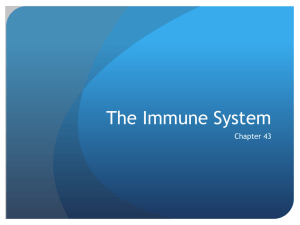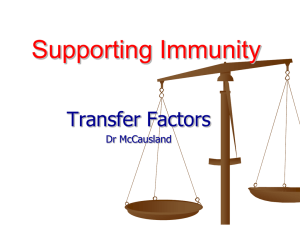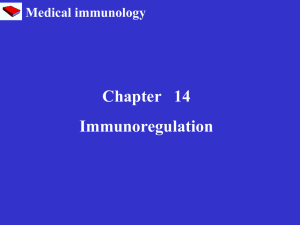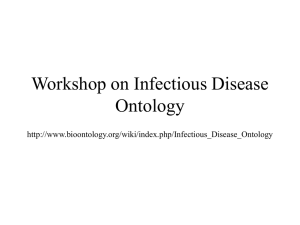January 6, 2014 - Immunology Overview
advertisement
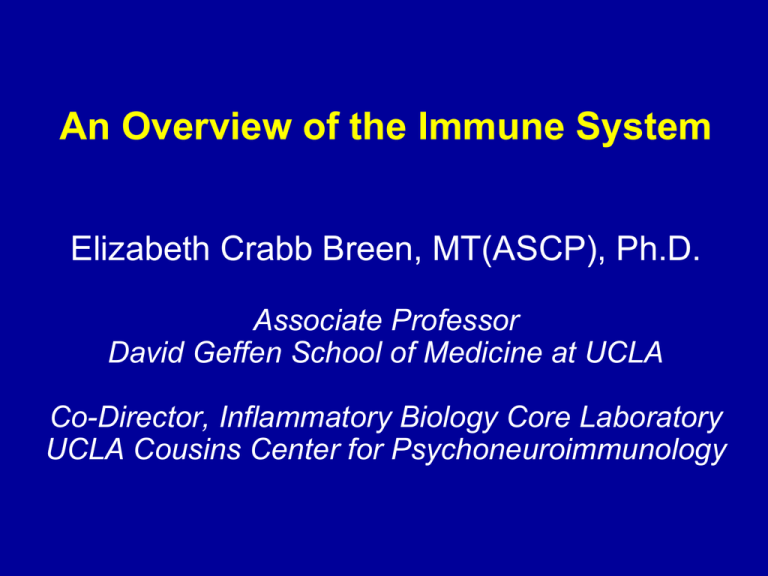
An Overview of the Immune System Elizabeth Crabb Breen, MT(ASCP), Ph.D. Associate Professor David Geffen School of Medicine at UCLA Co-Director, Inflammatory Biology Core Laboratory UCLA Cousins Center for Psychoneuroimmunology a) The cells of the immune system b) Essential cell surface molecules c) Innate immune responses d) Adaptive immune responses i. What happens in an antibody response? ii. What happens in a cell-mediated response? a) The cells of the immune system Figure from Parham, P., 2000, The Immune System, Garland Publishing Figure from Parham, P., 2000, The Immune System, Garland Publishing Figure from Parham, P., 2000, The Immune System, Garland Publishing b) Essential cell surface molecules MONOCLONAL ANTIBODY = HOMOGENEOUS PREPARATION OF ANTIBODY MOLECULES, ALL OF WHICH RECOGNIZE THE SAME ANTIGEN Produced by hybridomas, which are clones of cells resulting from the fusion of a normal, antibody-secreting B cell and an immortal myeloma cell CLUSTER OF DIFFERENTIATION (CD) = ALL MONOCLONAL ANTIBODIES THAT REACT WITH A PARTICULAR LEUKOCYTE MEMBRANE MOLECULE As of 2010 HLDA Workshop, up to CD363; HDLA HCDM http://www.hcdm.org/HLDA9Workshop/tabid/60/Default.aspx Commonly used CDs: Cell Types CD3: ALL T CELLS CD4: T HELPER CELLS CD8: T CYTOTOXIC CELLS CD19, 20, 21: B CELLS CD14: MONOCYTE/MACROPHAGE CD16, CD56: NATURAL KILLER CELLS Activation, Differentiation Markers CD25: Interleukin-2 Receptor CD28: Co-stimulatory receptor on T cells CD34: Stem cell marker CD38: Activation marker • MHC = MAJOR HISTOCOMPATABILITY COMPLEX in humans: HLA = HUMAN LEUKOCYTE ANTIGENS MHC CLASS I II HLA TYPES A, B, C LOCATION VIRTUALLY ALL NUCLEATED CELLS DP, DQ, DR B CELLS, MONOCYTES/ MACROPHAGES, DENDRITIC CELLS; ACTIVATED T CELLS Markers of self vs. non-self ANTIGEN RECEPTORS Required for specificity of immune system B cells: membrane-bound immunoglobulin a.k.a. B cell receptor (BCR) T cells: T cell receptor (TCR) Figure from Parham, P., 2000, The Immune System, Garland Publishing Responsible for tremendous diversity of immune system Dr. Breen , c) Innate immune responses Anatomic, Physiologic barriers • Intact skin • Salivary enzymes • Stomach acid • Etc. If breached rapid but non-specific responses to low dose, low virulence antigen/pathogens Inflammation • PMNs, monocyte/macrophage = phagocytosis • Induction of complement cascade, acute phase proteins (C’-reactive protein or CRP) • Fever response (Interleukin 1 or IL-1) c) Innate immune responses Rapid but non-specific responses to low dose, low virulence antigen/pathogens Inflammation • phagocytosis • complement cascade, acute phase proteins • fever response Non-specific cell-mediated responses • abnormal cells NK cells Figure from Parham, P., 2000, The Immune System, Garland Publishing c) Innate immune responses Rapid but non-specific responses to low dose, low virulence antigen/pathogens Inflammation • phagocytosis • complement cascade, acute phase proteins • fever response Non-specific cell-mediated responses • abnormal cells NK cells • bacteria “toll-like receptors” (TLR) Figure from Kindt, Goldsby, & Osborne, 2007, Kuby Immunology 6th Ed., W.H. Freeman and Co. c) Innate immune responses Rapid but non-specific responses to low dose, low virulence antigen/pathogens Require no previous exposure to antigen Do not improve with repeated exposure to same antigen d) Adaptive (antigen-specific) immune responses Four hallmarks of specific immune responses: 1. Self/non-self recognition 2. Specificity 3. Diversity 4. Memory Immunologic Memory Faster response, Greater magnitude, Longer duration Figure from Kindt, Goldsby, & Osborne, 2007, Kuby Immunology 6th Ed., W.H. Freeman and Co. Immunologic Memory » Faster response » Greater magnitude » Longer duration “Citius, Altius, Fortius” (Faster, Higher, Stronger) Photo by E. Rosenberger, from Games of the XXIIIrd Olympiad Los Angeles 1984 Commemorative Book Not cleared by innate response and/or high dose, high virulence antigen/pathogens 2 types of antigen-specific immune responses: HUMORAL RESPONSE CELL-MEDIATED RESPONSE HUMORAL RESPONSE = antibodies produced by immunoglobulin-secreting B cells (plasma cells) • Directed against soluble antigens, i.e., freefloating bacteria, proteins, etc. CELL-MEDIATED RESPONSE = killing of cells by cytotoxic T lymphocytes (CTL) • Directed against infected/defective cells, nonself cells What happens in an antibody (humoral) response? What happens in a cell-mediated response?




